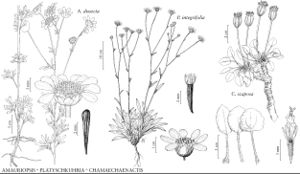Amauriopsis
in N. L. Britton et al., N. Amer. Fl. 34: 37. 1914.
| Taxon | Illustrator ⠉ | |
|---|---|---|
 | Amauriopsis dissecta Platyschkuhria integrifolia Chamaechaenactis scaposa | Barbara Alongi Linda Ann Vorobik Linny Heagy |
Biennials (sometimes flowering in first-year, sometimes persisting), 10–80+ cm. Stems erect, usually branched distally, sometimes from bases. Leaves usually basal and cauline; alternate; petiolate; blades deltate to ovate or oblong (in broad outline), usually 1–2-ternately lobed (lobes mostly oblong to obovate), ultimate margins entire or toothed, faces ± scabrellous to hirtellous, usually glanddotted. Heads radiate, in loose, corymbiform arrays. Involucres ± hemispheric or broader, 10–18+ mm diam. Phyllaries persistent, 12–21+ in ± 2 series (reflexed in fruit, distinct, ± oblanceolate or lanceolate to lance-attenuate, subequal, thin-herbaceous, margins membranous, sometimes purplish, apices usually attenuate to ± caudate). Receptacles convex, pitted, epaleate. Ray-florets 10–21+, pistillate, fertile; corollas yellow. Disc-florets 30–80+, bisexual, fertile; corollas yellow, tubes longer than funnelform throats, lobes 5, ± lanceolate (usually longer than throats). Cypselae obpyramidal, 4-angled, usually glabrous, sometimes hirtellous; pappi 0. x = 12.
Distribution
w United States, n Mexico
Discussion
Species 1.
Resurrection of Amauriopsis, which was included in Bahia Lagasca by W. L. Ellison (1964), is predicated largely on the work of B. G. Baldwin et al. (2002).
Selected References
Lower Taxa
"broader" is not a number.